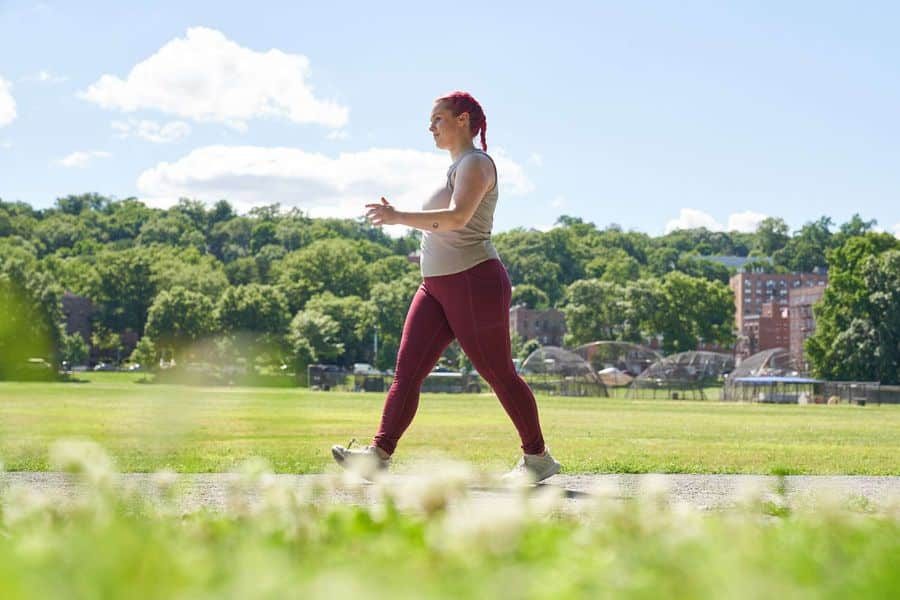Benefits of Cardio Walking
Similarities to Running Benefits
Guess what? A good stroll can offer some of the same perks as running! Walking swiftly can jumpstart your heart health, keep those pesky pounds off, and even lift your mood. Surprising, right?
Although pounding the pavement at a sprint scorches more calories in record time, tossing on some sneakers for a brisk walk can stack up similar gains if you go the distance. When you walk at a speed that gets you slightly out of breath—think about a brisk pace—that’s when you’re really doing your heart a favor. Imagine someone new to this hitting around 3 to 3.5 mph, while seasoned walkers might go from 3.5 to 4.5 mph (Healthline).
For those chasing a bit more intensity, raising your pace to about 4.5 mph or higher sends your Borg Scale (a fun little measure for exertion) up to 15 or 16.
| Intensity Level | Borg Scale | Walking Pace (mph) |
|---|---|---|
| Moderate | 13-14 | 3 – 3.5 |
| Vigorous | 15-16 | 3.5 – 4.5+ |
Curious about how to nail the perfect pace? Swing by our article on walking speed for cardio.
Duration vs. Benefits
The CDC is throwing down the healthy gauntlet—get moving for at least 150 minutes each week at a moderate pace or go full-throttle for 75 minutes. Aiming for five lively walks of 30 minutes each does the trick.
Stretching those walks a bit, even at a cozy pace, can torch calories and keep your heart in good shape, much like running. The magic is in keeping it regular. Need a plan? Our walking workout plans have got your back.
| Weekly Activity | Duration (Minutes) | Health Benefit |
|---|---|---|
| Moderate-Intensity Walking | 150 | Gives your heart a boost, helps with shedding weight |
| Vigorous-Intensity Walking | 75 | Supercharges your heart, burns more calories |
Starting out? No rush! Ease into it with a moderate pace. Our how to start a walking routine guide is a nifty resource.
Sneaking walking into your life doesn’t just nudge you toward health—it shoves you there! From managing weight to flaunting a robust heart, walking’s got everyone covered. If you’re targeting weight loss in particular, we’ve penned a helpful article on walking for weight loss just for you.
Effective Walking Paces
Understanding how fast you walk can really boost your cardio game. Let’s break it down and see what speed works best for you.
Moderate vs. Vigorous Intensity
When you’re strolling at a moderate intensity, you should be puffing a bit, but not gasping. Imagine chitchatting with a friend—breathless, but still making sense! According to the Borg Scale, this is a 13 to 14 level of effort. Most folks cruise at this pace in about 13 to 20 minutes per mile, clocking around 3.0 to 4.5 mph.
Step things up a notch, and you’ve got vigorous intensity. Here, huffing and puffing takes precedence, and you might only be able to squeeze out short phrases or an enthusiastic grunt here and there. Vigorous means scoring a 15 to 16 on the Borg Scale and cruising faster than 13 minutes per mile, or pushing past 4.5 mph.
| Intensity Level | Borg Scale Rating | Speed/Mile | Speed (mph) |
|---|---|---|---|
| Moderate | 13-14 | 13-20 min | 3.0-4.5 mph |
| Vigorous | 15-16 | < 13 min | > 4.5 mph |
CDC Recommendations
The CDC gives a thumbs up to getting at least 150 minutes of moderate exercise, or 75 minutes of that heart-thumping vigorous stuff, every week. Bust these minutes out however you like—like, say, five breezy 30-minute power walks each week.
Mix and match different walking workout plans to find your groove, or check your walking speed for cardio gains.
Sprinkle in some walks for weight loss, fine-tune for heart health, or stride it out for stress relief. New to walking? Don’t sweat it, start with our beginner’s guide on how to start a walking routine.
Nailing the right pace and sticking with the CDC’s tips can help you make the most of your walking workouts, hitting those cardio and health targets without a hitch.
Optimal Walking Speeds
Picking the right walking tempo is key to hitting those fitness targets without wearing yourself out. Whether you’re just starting or a seasoned stride master, keep reading for tips to find your groove.
Starting Out Guidelines
If you’re new to the world of walking for weight loss, starting slow and steady wins the race. A brisk walk between 3 to 3.5 miles per hour (mph) is ideal—a sweet spot that gets your heart pumping without leaving you gasping for air (Healthline).
| Walking Pace | Intensity Level | Perceived Exertion (Borg Scale) |
|---|---|---|
| 3.0 – 3.5 mph | Moderate | 13 – 14 |
| 3.5 – 4.5 mph | Vigorous | 15 – 16 |
The Borg Scale of Perceived Exertion is your friend here—shoot for a comfy 13 to 14 on the scale. That way, you’ll know you’re working hard enough to break a sweat but not so much that you can’t chat with your walking buddy.
Need a nudge in the right direction? Check out our walking routine for beginners.
Advanced Pacing Strategies
Time to step it up? If you’re no stranger to sidewalks and are seeking more from your walks, then it’s time to pump up the pace and try some next-level moves for better heart health and walking for fat loss. Walk at 3.5 to 4.5 mph for some vigorous action. Surpassing the 5 mph mark is where racewalking starts (Healthline).
| Walking Pace | Intensity Level | Activity |
|---|---|---|
| 3.5 – 4.5 mph | Vigorous | Advanced Walkers |
| > 5 mph | Vigorous | Racewalking |
Here’s how to up your game:
- Interval Walking: Mix it up. Go brisk for 2 minutes, then racewalk for 1 minute. Cycle through this for 30 minutes and watch those calories burn.
- Hill Walking: Elevate your routine with slopes and inclines. Hills work different muscles and get your heart racing.
- Weighted Walking: Add some ankle or wrist weights to kick it up a notch—no need to change the pace, just feel the added burn.
The Centers for Disease Control and Prevention (CDC) advises hitting that 150 minutes of moderate-intensity, or 75 minutes of vigorous action a week mark (Healthline). For tailored options, swing by our walking workout plans.
Mix these tips into your walks to find the optimal walking speed for cardio that matches your goals. Looking for a little zen with your steps? Don’t miss our section on walking for stress relief.
Enjoyable Walking Techniques
Making Walking Fun
Let’s face it, if you enjoy something, you’re way more likely to keep doing it. The trick is to make your strolls something you can’t wait to get out the door for. So, here’s the lowdown on spicing up your walks:
-
Tune In: Pop in those earbuds and throw on some killer tunes or dive into that podcast everyone’s been raving about. It’ll feel like the walk was over before it even started.
-
Company Matters: Go on, drag some friends or family along. There’s no better way to catch up on the latest gossip or swap silly stories than while pounding the pavement.
-
New Hangouts: Don’t be a creature of habit. Mix it up by strutting through different hoods, nearby parks, or those cool nature spots you’ve been meaning to check out. Fresh scenery equals fresh vibes.
-
Set Your Bar: With gadgets like pedometers or those fancy walking apps, you can challenge yourself. Hit those step goals, and give yourself a well-deserved pat on the back (Verywell Fit).
-
Turn It Into Playtime: Who said games are for kids? See who can spot the most landmarks or beat your step-count challenge. Before you know it, time will disappear.
For more fresh ideas to keep that walking routine exciting, take a peek at our piece on walking workout plans.
Importance of Enjoyment
Enjoyment isn’t just a nice bonus—it’s the secret sauce for keeping your walks a regular habit. Let’s break it down:
-
Keep at It: Sticking with anything long-term needs a bit of fun thrown in. Make your walks the part of the day you hate to miss.
-
Mind Over Miles: Enjoyment has a nifty way of clearing your mind. Banish those blues as you soak in the sights and sounds around you (Verywell Fit).
-
Body Benefits: Staying on the go means ticking off that 150 minutes of weekly activity the CDC bangs on about, keeping your health in tip-top shape (Healthline).
-
Fueling Your Fire: When you love what you do, it gives you that extra push, especially on days when the last thing you want to do is move.
To dive deeper into keeping your routine interesting, take a look at our guide on how to start a walking routine.
Enjoyable Walking Tips
| Technique | Description |
|---|---|
| Music Magic | Stream playlists or podcasts that bring a smile. |
| Stroll with Pals | Get your favorite folks to join in. |
| Scout New Routes | Roam different areas and enjoy the shifts in scenery. |
| Goal Setting | Monitor your progress using apps for steps or distance. |
| Walk n’ Play | Engage in fun games like “Spot the Landmark”. |
When walking becomes something you actually look forward to, it’s like your cardio best friend. This enjoyment not only makes it easier to stick with, but it’s great for losing some pounds or maintaining overall health (walking for weight loss). For more tricks and pro tips, don’t miss our article on tips for walking for weight loss.
Health Impacts of Brisk Walking
Heart Health Improvement
A good walk can be your heart’s best friend. Picking up the pace a bit, known as brisk walking, does wonders for your ticker. It gets the blood flowing, lowers that pesky blood pressure, and gives your heart a good workout. In fact, postmenopausal women who hit their stride for just half an hour each day might dodge a stroke, slashing risks by 40% if they’re brisk walkers, compared to 20% for those who take a slower route (That’s what the folks at UCLA Health tell us).
Here’s a quick look at how your heart gets a boost:
- Boosts blood flow
- Cuts down the chances of heart troubles
- Helps keep blood pressure in check
For more tips and tricks to keep your heart in top shape with walking, swing by our heart health walking guide.
| Health Metric | Brisk Walkers (30 min/day) | Slower Walkers (30 min/day) |
|---|---|---|
| Stroke Risk Reduction | 40% | 20% |
Weight Management Benefits
Want to keep that waistline in check without finding yourself in a cavernous gym? Brisk walking’s got your back. It can torch around 300 calories in just an hour for someone who’s about 150 pounds (UCLA Health). Keep at it, and you’ll create that magical calorie deficit leading to weight loss.
Why brisk walking rocks for managing weight:
- Burns those calories
- Gives your metabolism a good kick
- Tones those muscles
Curious how walking can help you shed some pounds? Head over to our guides on walking for weight loss and walking for fat loss.
| Weight (lbs) | Calories Burned per Hour |
|---|---|
| 120 | 240 |
| 150 | 300 |
| 180 | 360 |
Add brisk walking into your daily hustle, and you’ll tick both the heart health and weight management boxes. Check out our walking workout plans and get started with beginner walking routines to jump-start your path to a healthier you.
Walk for Joint Health
Oh, the joys of putting one foot in front of the other! Regular walking is a superb way to boost your health, especially when it comes to keeping those joints of yours in tip-top shape. If you’ve got joint pain or arthritis, finding that sweet walking speed for cardio can make all the difference.
Reducing Joint Pain
Walking, bless its heart, is a low-impact workout that’s much kinder to your joints than pounding the pavement with a jog. A study back in 2016 informed us that the force your joints deal with during a walk is way less than what they encounter in a run. It’s like treating your joints to a spa day instead of a boot camp; it’s safe, relaxing, and a whole lot gentler, especially if those joints have been giving you a hard time.
The folks over at UCLA Health say that consistent walking can really take the sting out of joint pain. It’s a bit like having a magic wand, offering relief that can match some over-the-counter pills but with none of the nasties. So, weave some walking into your daily routine and watch how your joints will sing your praises over time.
Impact on Arthritis
Living with arthritis doesn’t mean couch patrol is your only option. Walking is, hands down, a great way to tackle those pesky symptoms. When you walk briskly, you’re enjoying a moderate workout that takes it easy on your joints. This makes it the perfect cardio exercise for those who have arthritis, helping to dial down the pain and stiffness without making the situation worse (Healthline).
One big win with walking for arthritis is how it gets the blood flowing. That boost in circulation keeps those joints well-oiled and less cranky. Plus, it bulks up the muscles that support your joints, giving you a bit of pain payback (UCLA Health).
For the skinny on how stepping out can help other parts of your life, check out our articles on walking to lose weight and walking for a healthier heart.
Making walking part of your lifestyle doesn’t just tackle arthritis; it rolls out a welcome mat for a bunch of other health perks. Follow our walking workout plans and beginner routines, and you could start a sweat session that takes care of both your creaky joints and your overall health.
Walking for Cognitive Health
Taking a stroll at a steady pace isn’t just good for your heart and waistline; it’s also a brain booster. Here, we’ll chat about how making walking a habit can keep your mind sharp and help you feel better upstairs.
Decreased Cognitive Decline
Putting one foot in front of the other regularly is thought to help fend off mental fog because it keeps the heart happy, lessens the chance of a stroke, and helps lift your spirits (UCLA Health). Getting the blood pumping to your brain is a top-notch way to keep those grey cells ticking and avoid troubles like dementia.
Recommended Walking Duration and Intensity for Cognitive Health
| Activity Level | Duration Per Week | Intensity |
|---|---|---|
| Moderate-Intensity | 150 minutes | Moderate |
| Vigorous-Intensity | 75 minutes | Vigorous |
Source: Healthline
Sticking to these walk times and effort levels gives your brain the best shot. Keeping an eye on your pace and heart rate means you’re moving to the beat that’s right for you.
For more on getting your walking rhythm just right, check out our guide on walking speed for cardio.
Positive Impacts on Mental Health
Walking does wonders for mental health, easing the blues, and calming nerves. This simple exercise can give your mood a lift thanks to the release of endorphins – those tiny mood boosters running through your body.
Stepping outside to walk adds the extra perks of nature. The fresh air and sunlight aren’t just feel-good fluff; they genuinely boost mental well-being.
Here’s a quick look at how walking turns the frown upside down:
- Calms the mind and relieves tension.
- Boosts mood and mental health.
- Builds self-esteem and confidence.
- Enhances sleep quality.
- Dials down anxiety and depression symptoms.
Want to use walking as a stress-buster? We’ve got the scoop in our article on walking for stress relief.
Rolling walking into your daily grind pays dividends for both mind and body, making it an essential part of your wellness toolkit.










